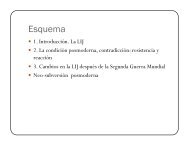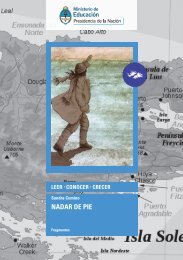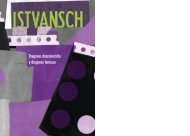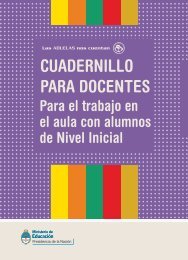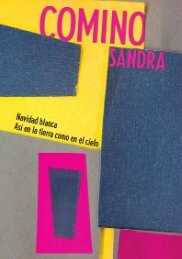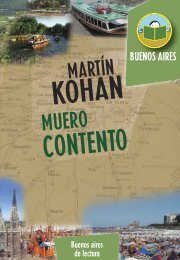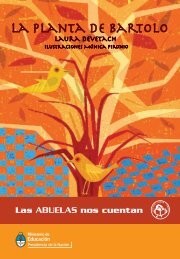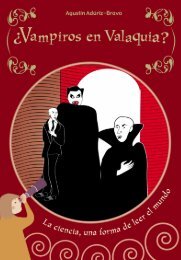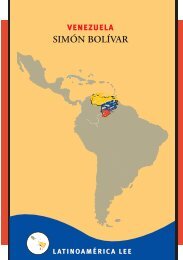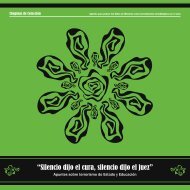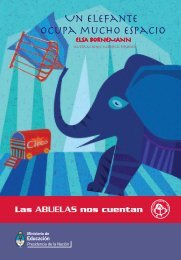MUNDOS POSIBLES. - Plan Nacional de Lectura - Educ.ar
MUNDOS POSIBLES. - Plan Nacional de Lectura - Educ.ar
MUNDOS POSIBLES. - Plan Nacional de Lectura - Educ.ar
Create successful ePaper yourself
Turn your PDF publications into a flip-book with our unique Google optimized e-Paper software.
6. Ciencias aplicadas<br />
7. Arte. Música. Deportes<br />
8. Lingüística y Literatura<br />
9. Geografía. Historia<br />
CUADRO DE REFERENCIAS PARA DOCENTES<br />
CDU COLOR TEMÁTICA ÍCONO<br />
Este sistema, que permite reunir temáticamente los materiales i<strong>de</strong>ntificados bajo un<br />
sistema <strong>de</strong> números, colores o íconos, en el caso <strong>de</strong>l nivel inicial <strong>de</strong>berá ser adaptado<br />
según las posibilida<strong>de</strong>s <strong>de</strong> niñas y niños <strong>de</strong> la edad.<br />
El esquema numérico se pue<strong>de</strong> <strong>ar</strong>m<strong>ar</strong> en una gran c<strong>ar</strong>tulina que se coloc<strong>ar</strong>á en la sala<br />
en un lug<strong>ar</strong> visible p<strong>ar</strong>a los niños. Ellos podrán apren<strong>de</strong>r a relacion<strong>ar</strong> la imagen <strong>de</strong>l<br />
número con la temática <strong>de</strong> los libros, que pue<strong>de</strong> est<strong>ar</strong> representada también por texto<br />
e imagen.<br />
Otra forma <strong>de</strong> organiz<strong>ar</strong> los materiales en la biblioteca <strong>de</strong>l j<strong>ar</strong>dín es utilizando la<br />
“M<strong>ar</strong>g<strong>ar</strong>ita <strong>de</strong> colores”, que asigna un color <strong>de</strong>terminado a cada una <strong>de</strong> las 10 clases<br />
principales <strong>de</strong> la CDU. (ver imagen)<br />
También, en este caso, la m<strong>ar</strong>g<strong>ar</strong>ita <strong>de</strong>bería est<strong>ar</strong> en un lug<strong>ar</strong> visible p<strong>ar</strong>a que los<br />
niños vayan aprendiendo a relacion<strong>ar</strong> el color con la temática <strong>de</strong> los libros.<br />
En la p<strong>ar</strong>te inferior <strong>de</strong>l lomo <strong>de</strong> cada libro, se <strong>de</strong>berá coloc<strong>ar</strong> una pequeña cinta o<br />
etiqueta con el color que corresponda p<strong>ar</strong>a que sea fácilmente i<strong>de</strong>ntificable. Con el color,<br />
también se i<strong>de</strong>ntific<strong>ar</strong>á el estante o lug<strong>ar</strong> que se asigne p<strong>ar</strong>a ubic<strong>ar</strong> los libros. De esta<br />
manera, d<strong>ar</strong>emos la posibilidad <strong>de</strong> individualiz<strong>ar</strong> el tema y mantener reunidos todos los<br />
libros <strong>de</strong> una misma temática en un mismo lug<strong>ar</strong>.<br />
0<br />
1<br />
2<br />
3<br />
4<br />
5<br />
6<br />
7<br />
8<br />
9<br />
GENERALIDADES<br />
Consult<strong>ar</strong> y apren<strong>de</strong>r<br />
FILOSOFÍA<br />
Pens<strong>ar</strong> y conocerse<br />
RELIGIÓN<br />
Creer y or<strong>ar</strong><br />
CIENCIAS SOCIALES<br />
Vivir en sociedad<br />
[categoría vacía]<br />
CIENCIAS NATURALES<br />
Descubrir la naturaleza<br />
CIENCIA Y TECNOLOGÍA<br />
Investig<strong>ar</strong> e invent<strong>ar</strong><br />
ARTE Y DEPORTE<br />
Jug<strong>ar</strong> y cre<strong>ar</strong><br />
LITERATURA Y LENGUAJE<br />
Leer y disfrut<strong>ar</strong><br />
HISTORIA Y GEOGRAFÍA<br />
Viaj<strong>ar</strong> por el tiempo y los lug<strong>ar</strong>es<br />
MARGARITA<br />
La otra manera <strong>de</strong> organiz<strong>ar</strong> la biblioteca es mediante la <strong>de</strong>terminación <strong>de</strong> gran<strong>de</strong>s<br />
temáticas y su representación por medio <strong>de</strong> símbolos icónicos.<br />
Préstamo <strong>de</strong> los materiales<br />
LITERATURA Y<br />
LENGUAJE<br />
Leer y disfrut<strong>ar</strong><br />
ARTE Y DEPORTE<br />
Jug<strong>ar</strong> y cre<strong>ar</strong><br />
CIENCIA Y TECNOLOGÍA<br />
Investig<strong>ar</strong> e invent<strong>ar</strong><br />
6<br />
CIENCIAS<br />
NATURALES<br />
Descubrir la naturaleza<br />
HISTORIA Y<br />
GEOGRAFÍA<br />
Viaj<strong>ar</strong> por el tiempo y los lug<strong>ar</strong>es<br />
8<br />
7<br />
5<br />
9 0<br />
4<br />
GENERALIDADES<br />
Consult<strong>ar</strong> y apren<strong>de</strong>r<br />
3<br />
1<br />
2<br />
FILOSOFÍA<br />
Pens<strong>ar</strong> y conocerse<br />
RELIGIÓN<br />
Creer y or<strong>ar</strong><br />
CIENCIAS SOCIALES<br />
Vivir en sociedad<br />
¿Qué es y p<strong>ar</strong>a qué sirve<br />
El préstamo es uno <strong>de</strong> los servicios básicos que ofrece una biblioteca. Implica permitir<br />
la salida <strong>de</strong> los libros hacia la casa <strong>de</strong> los niños, p<strong>ar</strong>a promover <strong>de</strong> esta forma su<br />
uso, el aprendizaje y la lectura fuera <strong>de</strong>l ámbito <strong>de</strong>l j<strong>ar</strong>dín.<br />
¿Cómo se hace<br />
El préstamo <strong>de</strong>be realiz<strong>ar</strong>se en forma or<strong>de</strong>nada p<strong>ar</strong>a saber qué se prestó y a quién.<br />
Existen diferentes modalida<strong>de</strong>s p<strong>ar</strong>a mantener el registro <strong>de</strong> los préstamos, y su elección<br />
<strong>de</strong>pen<strong>de</strong>rá <strong>de</strong> la cantidad <strong>de</strong> material y <strong>de</strong> niños, <strong>de</strong>l tiempo disponible y <strong>de</strong> la<br />
metodología utilizada.<br />
En el Nivel Inicial, la forma más a<strong>de</strong>cuada <strong>de</strong> realiz<strong>ar</strong> el control es a través <strong>de</strong> una<br />
planilla <strong>de</strong> préstamos.<br />
60<br />
61



